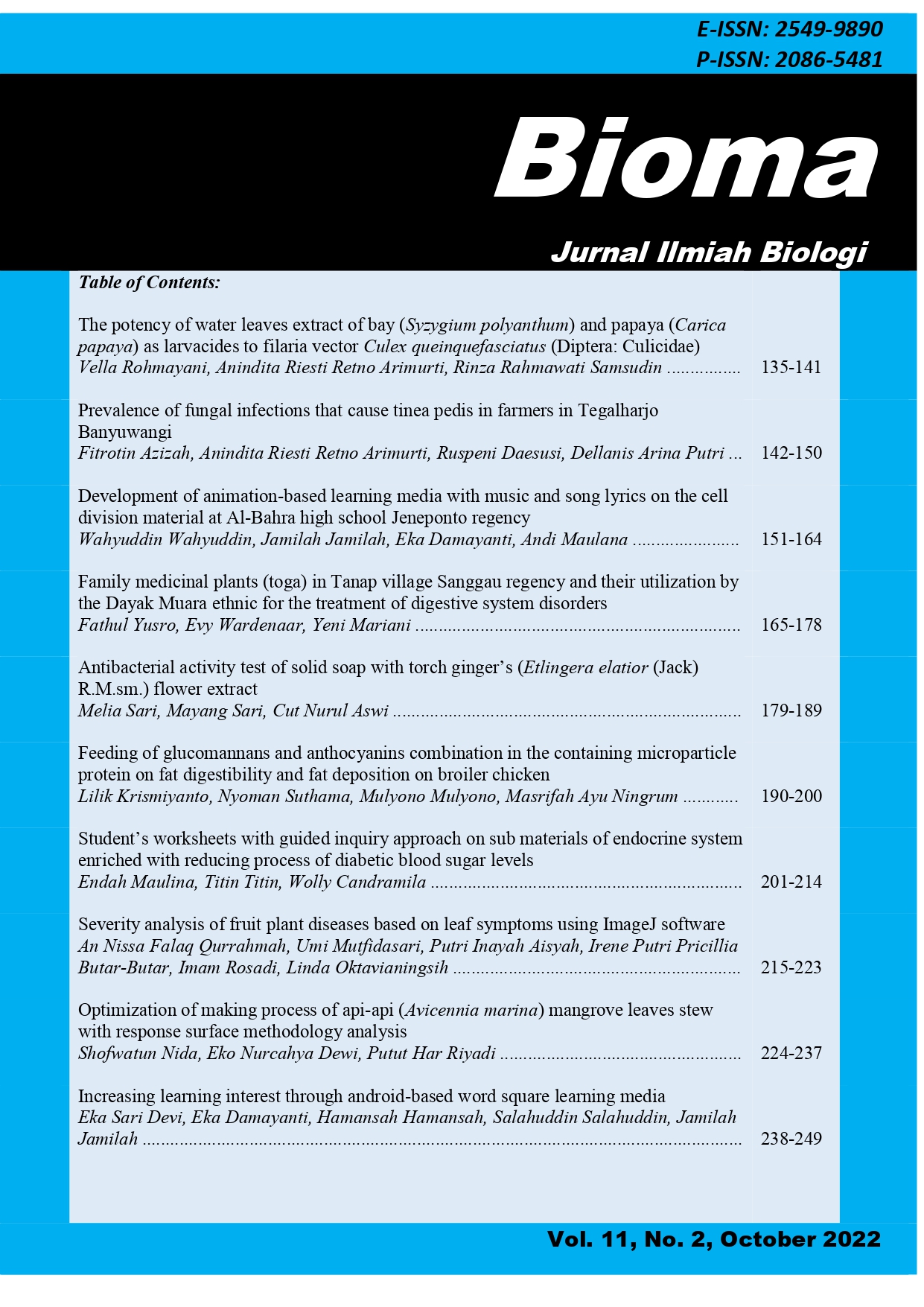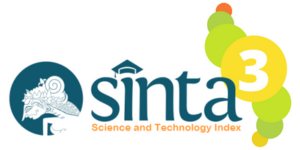ACTIVITY OF NONI EXTRACT (Morinda citrifolia L.) AS A BIOFUNGICIDE AGAINST THE GROWTH OF THE FUNGUS Fusarium oxysporum IN VITRO
DOI:
https://doi.org/10.26877/bioma.v14i1.1185Keywords:
Ethyl acetate extract, In vitro, Fungicide, Methanol extractAbstract
Fusarium oxysporum is a fungus that attacks various plants and causes wilting. Several plants, including bananas, have experienced a decrease in productivity due to the Fusarium fungus. This research aims to determine the effect of the whole plant of noni plants (fruits, leaves, and twigs), methanol extract, and ethyl acetate on the growth of fusarium fungi. To determine the optimal extract concentration to inhibit fungal growth. This research is a factorial study with independent variables in the form of extract, ingredients (fruit, leaves, and twigs), and differences in concentration. The activity of the extract as a biofungicide was analyzed based on the fungal growth inhibition zone. The results were analyzed using Anava and continued with the Duncan test. The research results show that methanol extract and ethyl acetate extract of noni have the potential as bio fungicides for the fungus Fusarium oxysporum. Noni fruit ethyl acetate extract at a concentration of 80% is optimum for inhibiting the growth of Fusarium oxysporum
References
Aji, O. R., & Romawati, Y. (2020). Antifungal Activity of Morinda citrifolia Leaf Extracts Against Fusarium oxysporum. Indonesian Journal of Biotechnology and Biodiversity, 4(1), 20–26. https://doi.org/10.47007/ijobb.v4i1.51
Aji, O. R., & Roosyidah, L. H. (2020). Antifungal Activity of Morinda citrifolia leaf extracts against Colletotrichum acutatum. Biogenesis: Jurnal Ilmiah Biologi, 8(1). https://doi.org/10.24252/bio.v8i1.12009
Ali, M., Kenganora, M., & Manjula, S. N. (2016). Health Benefits of Morinda citrifolia (Noni): A Review. Pharmacognosy Journal, 8(4). https://doi.org/10.5530/pj.2016.4.4
Aprilia, I., Maharijaya, A., Sobir, & Wiyono, S. (2020). Keragaman Genetik dan Ketahanan terhadap Penyakit Layu Fusarium (Fusarium oxysporum f.sp cepae) Bawang Merah (Allium cepa L. var. Aggregatum) Indonesia. Jurnal Agrikultura Indonesia, 11(1), 32–40. http://dx.doi.org/10.29244/jhi.11.1.32-40
Asrul, A.-, Rosmini, R., Rista, A., Astuti, I. D., & Yulianto, A. (2021). Karakterisasi Jamur Penyebab Penyakit Busuk Pangkal Batang (Basal Rot) pada Bawang Wakegi (Allium x wakegi Araki). Agro Bali : Agricultural Journal, 4(3), 341–350. https://doi.org/10.37637/ab.v4i3.835
Avyani, H. B., & Piyanto, S. (2020). Analisis Efektivitas Probiotik di Dalam Produk Kecantikan sebagai Antibakteri terhadap Bakteri Staphylococcus epidermidis. Berkala Bioteknologi, 3(2).
Azzahra, N., Jamilatun, M., & Aminah. (2020). Perbandingan Pertumbuhan Aspergillus fumigatus pada Media Instan Modifikasi Carrot Sucrose Agar dan Potato Dextrose Agar. Jurnal Mikologi Indonesia, 4(1), 1. https://doi.org/10.46638/jmi.v4i1.69
Chan-Blanco, Y., Vaillant, F., Pérez, A. M., Reynes, M., Brillouet, J., & Brat, P. (2006). The noni fruit (Morinda citrifolia L.): A review of agricultural research, nutritional and therapeutic properties. Journal of Food Composition and Analysis, 19(6–7), 645–654.
Deng, S., West, B. J., Palu, A. K., & Jensen, C. J. (2010). Determination and comparative analysis of major iridoids in different parts and cultivation sources of Morinda citrifolia. Phytochemical Analysis, 22(1), 26–30. https://doi.org/10.1002/pca.1246
Gazali, M., Nufus, H., Nurjanah, & Zuriyat. (2019). Eksplorasi Senyawa Bioaktif Ekstrak Daun Nipah (Nypa fruticans Wurmb) Asal Pesisir Aceh Barat Sebagai Antioksidan. Jurnal Pengolahan Hasil Perikanan IndonesiaHPI, 22(1), 155–163. https://journal.ipb.ac.id/index.php/jphpi/article/view/25892/16875
Hamilton, X., & Jaikishun, S. (2023). The effect of morinda citrifolia ethanolic extract against malassezia globosa obtained from the scalp of individuals between the ages of 18-24 in Georgetown, Guyana. Journal of Advances in Microbiology, 23(11). https://doi.org/10.9734/jamb/2023/v23i11771
Haryanti, S., Larasati, R. D., & Agusta, H. (2020). Optimasi Waktu Maserasi Dan Konsentrasi Daun Sirih Hijau (Piper betle Linn) dalam Pembuatan Gel Antiseptik Kulit. Konservasi, 9(2), 17–24.
Kim, Y., Pyeon, J., Lee, J.-Y., Kim, E.-M., La, I.-J., Lee, O.-H., Kim, K., Sung, J., & Kim, Y. (2024). Chemical fingerprint analysis of fermented Morinda citrifolia L. (Noni) juice by UHPLC Q-TOF/MS combined with chemometric analysis. Applied Biological Chemistry, 67(59).
Meilawati, L., Ernawati, T., Dewi, R. T., Megawati, & Sukirno. (2021). Study of total phenolic, total flavonoid, scopoletin contents and antioxidant activity of extract of ripened noni juice. Jurnal Kimia Terapan Indonesia, 23(2), 55–62.
Muaja, M. G. D., Runtuwene, M. R. J., & Kamu, V. S. (2017). Aktivitas Antioksidan Ekstrak Metanol dari Daun Soyogik (Saurauia bracteosa DC.). Jurnal Ilmiah Sains, 17(1). https://doi.org/10.35799/jis.17.1.2017.15614
Pamungkas, B. T., Muktiwardojo, M., & Rostianawati, T. (2019). Review: Antibacterial Activities Of Various Parts Of Mengkudu (Morinda citrifolia L.) Plants On Some Species Of Bacteria. Pharmacy and Chemistry, 4(5), 5–10. https://jtpc.farmasi.unmul.ac.id/index.php/jtpc/article/view/207
Pinaria, A. G., & Assa, B. (2017). Jamur Patogen Terbawa Tanah (1st ed.). Media Nusa Creative.
Putri, D. R., Asri, M. T., & Ratnasari, E. (2019). Aktivitas Antifungi Ekstrak Buah Pare (Momordica charantia L.) dalam Menghambat Pertumbuhan Jamur Fusarium oxysporum. LenteraBio, 8(2), 156–161.
Runtuwene, M. R. J., Kamu, V. S., & Rotty, M. (2021). Aktivitas Antioksidan Fraksi Etil Asetat dan Fraksi Heksana Daun Soyogik ( Saurauia bracteosa DC ) terhadap Oksidasi Asam Linoleat. Journal Unsrat Chemprog, 14(2), 138–145.
Sari, W., Wiyono, S., Nurmansyah, A., Munif, A., & Poerwanto, R. (2018). Keanekaragaman dan Patogenisitas Fusarium spp. Asal Beberapa Kultivar Pisang. Jurnal Fitopatologi Indonesia, 13(6), 216. https://doi.org/10.14692/jfi.13.6.216
Savitri, I., Suhendra, L., & Wartini, N. M. (2017). Pengaruh Jenis Pelarut pada Metode Maserasi terhadap Karakteristik Ekstrak Sargassum polycystum. Jurnal Rekayasa Dan Manajemen Agroindustri, 5(3). https://ojs.unud.ac.id/index.php/jtip/article/view/35504
Simatupang, O. C., Abidjulu, J., & Siagian, K. V. (2017). Uji daya hambat ekstrak daun mengkudu (Morinda citrifolia L.) terhadap pertumbuhan Candida albicans secara in vitro. Journal E-GiGi, 5(1). https://doi.org/10.35790/eg.5.1.2017.14701
Suryani, N. C., Permana, D. G. M., & AA GN Anom. (2016). Pengaruh Jenis Pelarut Terhadap Kandungan Total Flavonoid dan Aktivitas Antioksidan Ekstrak Daun Matoa (Pometia pinnata). ITEPA: Jurnal Ilmu Dan Terapan Pangan, 5(1). https://ojs.unud.ac.id/index.php/itepa/article/view/22645
Toh, S. C., Lihan, S., Bunya, S. R., & Leong, S. S. (2023). In vitro antimicrobial efficacy of cassia alata (linn.) leaves, stem, and root extracts against cellulitis causative agent staphylococcus aureus. BMC Complementary Medicine and Therapies, 23(1).
Torres, M., Magalhães, I., Mondêgo-Oliveira, R., Sá, J., Rocha, A., & Abreu-Silva. (2017). One plant, many uses: A review of the pharmacological applications of morinda citrifolia. Phytotherapy Research, 31(7), 971–979. https://doi.org/10.1002/ptr.5817
Wang, J., Li, C., Qiu, R., Li, X., Zhao, J., Bai, J., Chen, Y., & Li, S. (2021). Complete genome sequence of a novel mitovirus from the phytopathogenic fungus Fusarium oxysporum. Archives of Virology, 166(11), 3211–3216. https://doi.org/10.1007/s00705-021-05210-y
Zhang, W.-M., Wang, Wei, Zhang, J.-J., Wang, Z.-R., Wang, Y., Hao, W.-J., & Wu-Yang. (2016). Antibacterial constituents of hainan morinda citrifolia (noni) leaves. Journal of Food Science, 81(5). https://doi.org/10.1111/1750-3841.13302








